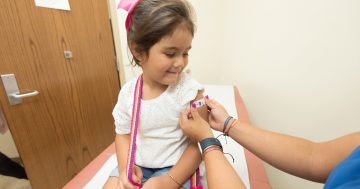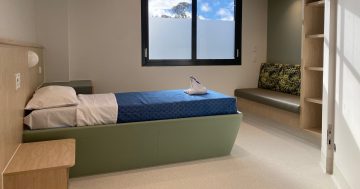
Isla (14) and her parents, Leonie and Rob McGregor, have nothing but praise for Canberra Health Services’ Hospital in the Home program (pictured with program nurse manager Mulu Gebremariam). Photo: Claire Fenwicke.
When it was discovered Isla, 14, had a bone infection in her right foot, she was facing two weeks in hospital hooked up to IV antibiotics.
Instead she was able to keep attending school and receive treatment at home through the newly-established Child and Adolescent Hospital in the Home program.
More than $15.8 million was invested in the 2023-24 ACT Budget to expand the paediatric workforce and deliver more services, including setting up this program.
It began operation earlier this year and has already helped more than 50 children and their families keep their routines while receiving hospital treatment.
Isla has never spent an extended period of time in hospital and so found the experience “a lot less stressful” than the alternative.
“[The nurses] would come over every afternoon, re-do the IV that I had in my arm, and they basically would put a new one in every night, as well as check on my foot and see how everything was doing,” she said.
Her father Rob McGregor hadn’t known about the service before they arrived at hospital, but described it as “brilliant”.
“She kept going to school, we maintained domestic routines … everywhere she went, the service went,” he said.
“When the team arrived, they were calm, they were professional, they were obviously very caring and they just treated Isla like gold.”
Phase One of the program provides a range of services, including IV antibiotic therapy for cellulitis or urinary tract infections, infusions of medications for blood clotting disorders or some autoimmune diseases, and step down wound care before a child is transitioned to outpatient services.
It also means children who are immunocompromised aren’t unnecessarily being exposed to infection risks by staying in hospital.
Program nurse manager Mulu Gebremariam said eight staff were rostered on to deliver the 24/7 service.
“It means if the family has any questions overnight, they can call the team for advice or they can come [to the hospital] as they’re considered as an in-patient,” she said.
Given the positive feedback thus far, the program is now being evaluated to expand to even more children and adolescents.
Patients can be referred to the program while in a hospital ward, outpatient service clinic or in the emergency department.
Health Minister Rachel Stephen-Smith said the establishment of a paediatric hospital in the home service was a key action in the Child and Adolescent Clinical Services Plan, and she was looking forward to ways it could be offered to more families.
“Home health care also encourages family involvement in the care process. By allowing family units to stay together, they can actively participate in a patient’s treatment and recovery without the extra stress of travel and separation,” she said.
“The ACT Government will continue to invest in paediatric services and the workforce to ensure Canberra’s children and young people have access to quality healthcare when and where they need it.”





















